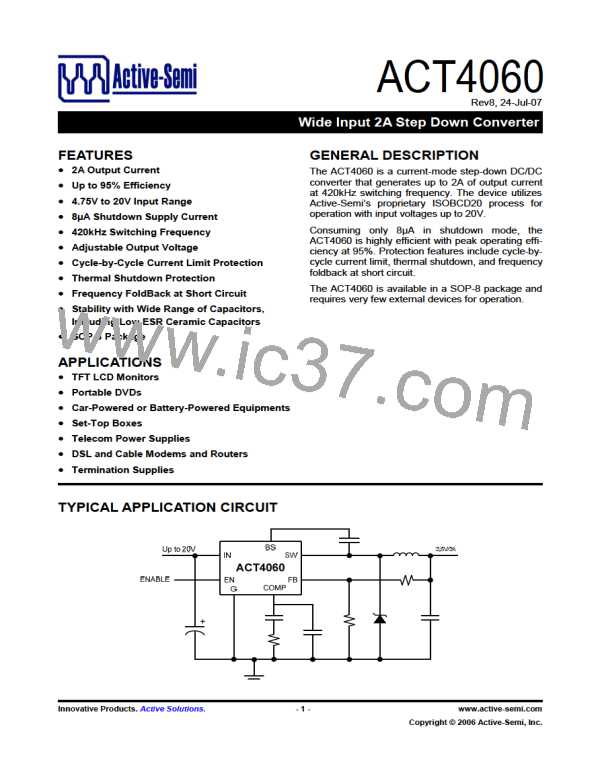ACT4060
Rev8, 24-Jul-07
Input Capacitor
APPLICATIONS INFORMATION
The input capacitor needs to be carefully selected
to maintain sufficiently low ripple at the supply input
of the converter. A low ESR capacitor is highly rec-
ommended. Since large current flows in and out of
this capacitor during switching, its ESR also affects
efficiency.
Output Voltage Setting
Figure 1:
Output Voltage Setting
VOUT
The input capacitance needs to be higher than
10µF. The best choice is the ceramic type, how-
ever, low ESR tantalum or electrolytic types may
also be used provided that the RMS ripple current
rating is higher than 50% of the output current. The
input capacitor should be placed close to the IN and
G pins of the IC, with the shortest traces possible.
In the case of tantalum or electrolytic types, they
can be further away if a small parallel 0.1µF ce-
ramic capacitor is placed right next to the IC.
ACT4060
RFB1
FB
RFB2
Figure 1 shows the connections for setting the out-
put voltage. Select the proper ratio of the two feed-
back resistors RFB1 and RFB2 based on the output
voltage. Typically, use RFB2 ≈ 10kΩ and determine
RFB1 from the following equation:
Output Capacitor
The output capacitor also needs to have low ESR to
keep low output voltage ripple. The output ripple
voltage is:
VOUT
RFB1 R
1
FB2
(1)
1.293V
Inductor Selection
VRIPPLE IOUTMAX KRIPPLERESR
The inductor maintains a continuous current to the
output load. This inductor current has a ripple that is
dependent on the inductance value: higher induc-
tance reduces the peak-to-peak ripple current. The
trade off for high inductance value is the increase in
inductor core size and series resistance, and the
reduction in current handling capability. In general,
select an inductance value L based on ripple current
requirement:
VIN
(3)
28 fSW 2LCOUT
where IOUTMAX is the maximum output current, KRIP-
PLE is the ripple factor, RESR is the ESR of the output
capacitor, fSW is the switching frequency, L is the
inductor value, and COUT is the output capacitance.
In the case of ceramic output capacitors, RESR is
very small and does not contribute to the ripple.
Therefore, a lower capacitance value can be used
for ceramic type. In the case of tantalum or electro-
lytic capacitors, the ripple is dominated by RESR
multiplied by the ripple current. In that case, the
output capacitor is chosen to have sufficiently low
ESR.
VOUT
VIN VOUT
L
(2)
VINfSW IOUTMAXKRIPPLE
where VIN is the input voltage, VOUT is the output
voltage, fSW is the switching frequency, IOUTMAX is
the maximum output current, and KRIPPLE is the rip-
ple factor. Typically, choose KRIPPLE = 30% to corre-
spond to the peak-to-peak ripple current being 30%
of the maximum output current.
For ceramic output capacitor, typically choose a
capacitance of about 22µF. For tantalum or electro-
lytic capacitors, choose a capacitor with less than
50mΩ ESR.
With this inductor value, the peak inductor current is
IOUT × (1 + KRIPPLE/2). Make sure that this peak in-
ductor current is less that the 3A current limit. Fi-
nally, select the inductor core size so that it does
not saturate at 3A. Typical inductor values for vari-
ous output voltages are shown in Table 1.
Rectifier Diode
Use a Schottky diode as the rectifier to conduct cur-
rent when the High-Side Power Switch is off. The
Schottky diode must have current rating higher than
the maximum output current and a reverse voltage
rating higher than the maximum input voltage.
Table 1:
Typical Inductor Values
VOUT
1.5V
1.8V
2.5V
3.3V
5V
L
6.8μH
6.8μH
10μH
15μH
22μH
Innovative Products. Active Solutions.
- 5 -
www.active-semi.com
Copyright © 2006 Active-Semi, Inc.

 ACTIVE-SEMI [ ACTIVE-SEMI, INC ]
ACTIVE-SEMI [ ACTIVE-SEMI, INC ]